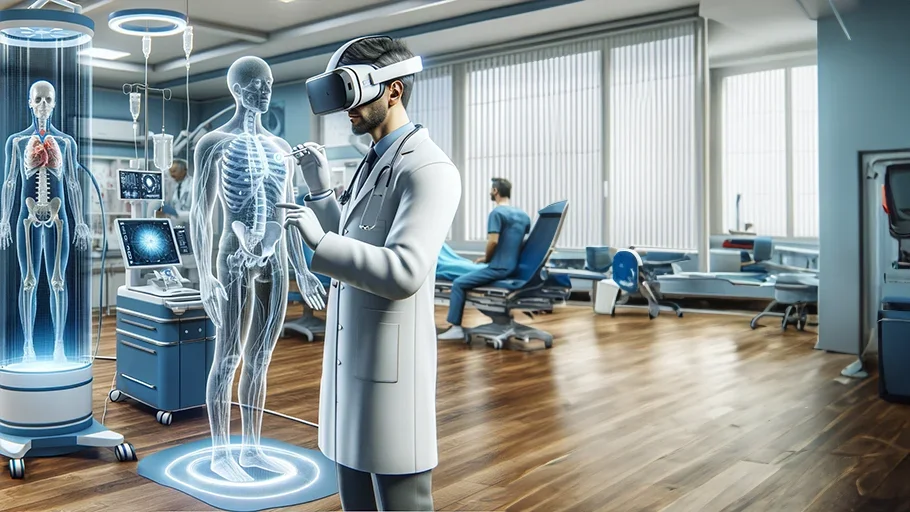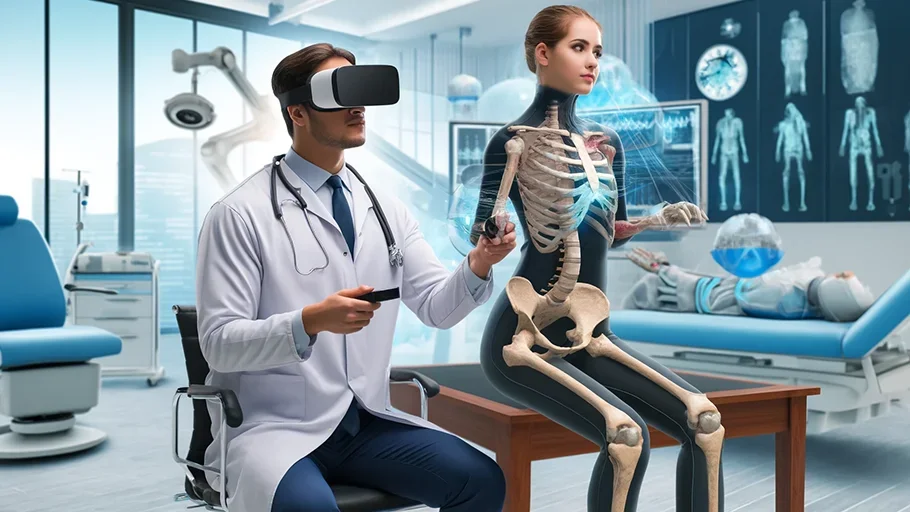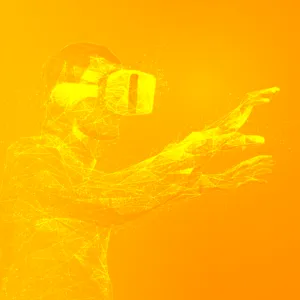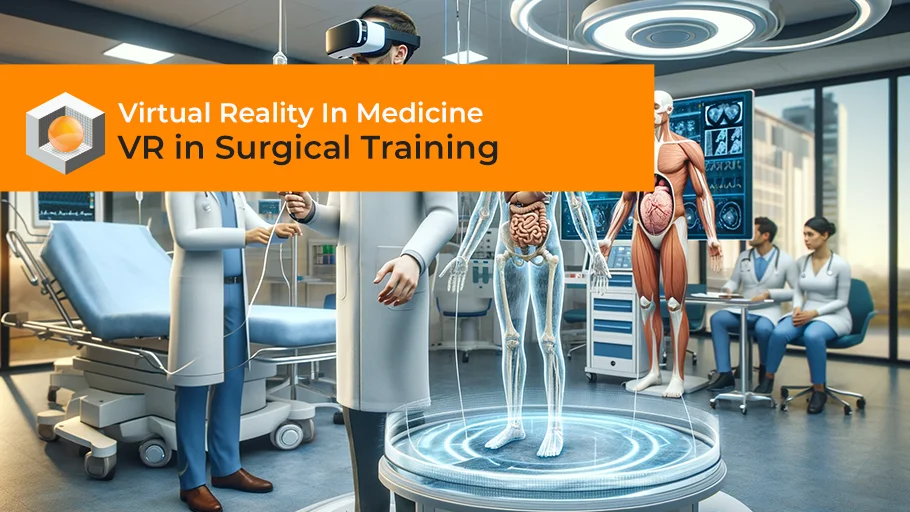Virtual reality in medicine, how virtual reality is transforming healthcare? Virtual Reality (VR) technology is revolutionizing the field of medicine, offering innovative solutions for surgical training, patient care, and rehabilitation. At the heart of this transformation is the ability of VR to create immersive, realistic simulations that enhance the learning and practice environment for medical professionals.
For surgical training, VR provides an invaluable tool, enabling students and experienced surgeons alike to practice and refine their skills in a risk-free setting. This technology not only improves the precision and efficiency of surgical procedures but also broadens the scope of medical education, allowing for a deeper understanding of complex anatomical structures and surgical techniques. Platforms like RoT STUDIO are pivotal in this regard, simplifying the creation of VR content for users without coding knowledge, thus making it more accessible to a wide range of medical professionals and institutions.
Virtual Reality in the Healthcare Industry
Furthermore, VR’s impact extends beyond professional training to patient care, particularly in rehabilitation where customized VR programs play a crucial role in improving outcomes. These programs offer engaging, tailored exercises that can significantly enhance motivation and adherence to treatment plans, while also providing opportunities for cognitive rehabilitation and pain management. The immersive nature of VR distracts patients from pain and makes rehabilitation exercises more enjoyable, leading to faster recovery times. As VR technology continues to advance and become more accessible, its integration into medical institutions worldwide is poised to further revolutionize patient care, education, and the overall healthcare experience, marking a new era in medicine.
How Virtual Reality is Revolutionizing Healthcare
The healthcare industry is undergoing a significant transformation, thanks to the integration of Virtual Reality technologies. These advancements are not just enhancing the way medical professionals train and plan for surgeries but also revolutionizing patient care and rehabilitation processes. At RoT STUDIO, we’re at the forefront of this revolution, providing tools that enable professionals, even without coding or technical knowledge, to create immersive and impactful VR experiences.
VR in Surgical Training and Planning
Surgical training and planning have traditionally been dependent on theoretical knowledge and hands-on practice on cadavers or through observing surgeries. However, VR is changing this landscape by offering a more interactive, immersive, and safer environment for training and planning.
- Realistic Simulations: At RoT STUDIO, we’ve developed VR modules that simulate real-life surgical scenarios, allowing surgeons and medical students to practice and hone their skills without the risk associated with real-life operations.
- Customizable Scenarios: Our platform enables the creation of specific surgical scenarios, tailored to the unique needs of the medical institution or the specific learning objectives of the students. This flexibility enhances the learning experience, making it more relevant and impactful.
- Enhanced Understanding: Through VR, surgeons can visualize complex surgeries in a three-dimensional space, offering a level of understanding and preparation that traditional methods cannot match. This is particularly beneficial for planning intricate procedures, where understanding the spatial relationships between different anatomical structures is crucial.
Enhancing Patient Care and Rehabilitation
Beyond training and planning, VR is also transforming patient care and rehabilitation, offering new ways to treat and manage various conditions.
- Pain Management: VR experiences can distract patients from pain, reducing their reliance on pain medication.
- Physical Rehabilitation: VR programs designed on our platform can simulate physical exercises that are engaging and tailored to the specific rehabilitation needs of the patient. This not only makes rehabilitation more enjoyable but can also track progress and adapt exercises accordingly.
- Mental Health Support: VR has shown great promise in treating mental health conditions, such as PTSD, anxiety, and phobias. By creating controlled, immersive environments, patients can safely confront and work through their issues, guided by healthcare professionals.
RoT STUDIO is proud to be part of this revolutionary journey, offering a platform that simplifies the creation of VR content. Whether it’s for surgical training, patient care, or rehabilitation, RoT STUDIO provides the tools necessary to transcend physical and geographical limitations, opening up new possibilities for collaboration and innovation in healthcare.

Virtual Reality in Medical Education
The integration of VR into medical education represents a significant leap forward, offering unparalleled opportunities for student engagement, comprehension, and skill acquisition. At RoT STUDIO, we understand the potential of VR to reshape the landscape of medical training, providing students with hands-on experience in a risk-free environment.
The Role of VR in Medical Student Training
VR technology has become an indispensable tool in medical student training, offering several key advantages over conventional learning methods:
- Immersive Learning: VR provides an immersive learning environment, allowing medical students to experience and interact with complex biological structures in three dimensions. This immersive experience facilitates a deeper understanding of human anatomy and physiological processes.
- Risk-Free Simulation: One of the most significant benefits of VR in medical education is the ability to simulate surgical procedures and medical scenarios without any risk to real patients. RoT STUDIO enables educators to create detailed simulations where students can practice and hone their skills, from basic procedures to complex surgeries, enhancing their competence and confidence.
- Interactive Engagement: VR technology supports interactive learning, engaging students in a way that lectures and textbooks cannot. Through VR, learners can perform virtual dissections, participate in simulated patient interactions, and receive immediate feedback on their actions, promoting active learning and retention.
Comparison with Traditional Education Methods
While traditional methods of medical education have their merits, the comparison with VR-based learning highlights several key differences:
- Practical Experience: Traditional education often relies heavily on theoretical knowledge, with limited opportunities for hands-on practice, especially in the early stages of medical training. VR eliminates this gap by offering practical experience from the outset, allowing students to apply their theoretical knowledge in simulated real-world scenarios.
- Engagement and Retention: Studies have shown that VR leads to higher levels of engagement and information retention among students compared to conventional learning methods. The interactive, immersive nature of VR stimulates more senses, enhancing memory retention and understanding.
- Accessibility and Scalability: Traditional medical training can be resource-intensive, requiring access to cadavers, hospital rotations, and specialized equipment. VR, on the other hand, is infinitely scalable and accessible, breaking down geographical and financial barriers to medical education. With platforms like RoT STUDIO, educators can develop and distribute VR content widely, ensuring a broader reach and democratizing medical education.
- Customization and Flexibility: Unlike traditional methods, VR content can be easily customized to suit the learning objectives, pace, and style of individual students. RoT STUDIO’s platform facilitates the creation of tailored VR experiences, allowing for a more personalized learning journey.
The Future of Virtual Reality in Medicine
The future of Virtual Reality (VR) in medicine is marked by exciting prospects and boundless opportunities. As we delve into cutting-edge research and innovations, and explore predictions and trends, it’s clear that VR is set to fundamentally alter the landscape of healthcare and medical education.
Cutting-edge Research and Innovations
The realm of VR in medicine is characterized by rapid advancements and innovative applications that extend well beyond current applications. At RoT STUDIO, we are at the forefront of exploring these possibilities:
- Enhanced Surgical Precision: VR is being integrated into surgical procedures, offering real-time, 3D visualizations of the patient’s anatomy. This enables surgeons to perform intricate operations with higher precision and better outcomes.
- Remote Surgery: With the advent of VR combined with robotics, the concept of remote surgery is becoming a reality. Surgeons can operate on patients from great distances, reducing the time and risks associated with transportation.
- VR-Assisted Rehabilitation: Cutting-edge VR programs are being developed to aid in the rehabilitation of stroke victims, individuals with brain injuries, and those undergoing physical therapy. These programs, designed for easy creation and customization on platforms like RoT STUDIO, provide engaging, personalized experiences that can improve recovery rates.
- Pain Management and Anxiety Reduction: Research is showing that VR can be an effective tool for managing pain and reducing anxiety in patients undergoing procedures. Immersive VR experiences distract the brain, offering a non-pharmacological alternative to traditional pain and anxiety management strategies.

Predictions and Trends
As we look to the future, several predictions and trends are emerging that highlight the growing role of VR in medicine:
- Widespread Adoption in Medical Training: VR is set to become a staple in medical education, with institutions worldwide adopting VR technologies for training purposes. The immersive, hands-on experience provided by VR enhances learning and retention, preparing students for real-world medical challenges.
- Expansion into Mental Health Treatments: VR’s potential in treating mental health issues, such as PTSD, anxiety disorders, and phobias, is gaining recognition. By creating controlled, immersive environments, therapists can guide patients through exposure therapy and other treatments in a safe, controlled manner.
- Increased Patient Engagement and Education: VR will play a significant role in patient education, helping individuals understand their conditions, treatment plans, and surgical procedures. This increased engagement can lead to better patient outcomes and satisfaction.
- Integration with Other Emerging Technologies: The future will see VR increasingly integrated with other technologies, such as artificial intelligence (AI) and machine learning, to create even more personalized and effective medical treatments and training programs.
At RoT STUDIO, we are excited to be part of this dynamic field, offering a platform that empowers professionals to push the boundaries of what’s possible in medicine with VR. As we continue to explore the frontiers of VR technology, we remain committed to unlocking new possibilities for medical treatment, training, and patient care, bridging the gap between virtual experiences and real-world applications.
Virtual Reality In Medicine Frequently Asked Questions (FAQs)
How Does Virtual Reality Benefit Surgical Training?
VR offers several significant advantages for surgical training:
- Realistic Simulations: VR provides highly realistic simulations of surgical procedures, allowing trainees to practice in a risk-free environment. This immersive experience is invaluable for developing a deep understanding of complex surgical techniques and anatomy.
- Repeatability: Unlike traditional training, which may be limited by availability of resources like cadavers or access to live surgeries, VR allows for unlimited practice sessions. Trainees can repeat procedures as often as needed to refine their skills.
- Performance Feedback: VR systems can track the user’s performance, providing immediate feedback on precision, timing, and decision-making. This feedback is crucial for self-assessment and improvement.
- Customizable Learning Experiences: With platforms like RoT STUDIO, educators can create customized training modules tailored to specific learning objectives, surgical techniques, or even rare medical conditions, enhancing the breadth and depth of surgical training.
Can VR Really Improve Patient Rehabilitation Outcomes?
Yes, VR has shown great promise in improving rehabilitation outcomes:
- Engagement and Motivation: VR makes rehabilitation exercises more engaging and enjoyable, which can significantly increase patient motivation and adherence to treatment plans.
- Tailored Rehabilitation Programs: VR applications can be customized to meet the specific rehabilitation needs of each patient, adjusting the difficulty level and types of exercises as the patient progresses.
- Cognitive and Physical Rehabilitation: Beyond physical therapy, VR supports cognitive rehabilitation for patients recovering from strokes or brain injuries. VR experiences can help improve attention, memory, and problem-solving skills.
- Reduced Perception of Pain: For patients undergoing painful rehabilitation processes, VR can provide a form of distraction therapy, reducing the perception of pain during exercises.
What Makes VR an Effective Tool for Medical Education?
VR’s effectiveness in medical education can be attributed to several factors:
- Immersive Learning: By simulating real-life medical scenarios, VR creates an immersive learning environment that enhances understanding and retention of complex concepts.
- Interactive Experience: VR supports active learning through interaction, allowing students to manipulate objects, conduct virtual dissections, and practice procedures, which improves learning outcomes compared to passive educational methods.
- Safe, Controlled Environment: VR provides a safe space for students to make mistakes and learn from them without the risk of harming actual patients.
- Scalability: VR can simulate a wide range of medical conditions and scenarios, from common procedures to rare diseases, providing a breadth of experience that would be difficult to achieve through traditional means.
How Accessible is VR Technology for Medical Institutions?
The accessibility of VR technology for medical institutions is improving rapidly:
- Cost Reduction: As VR technology matures, the cost of VR hardware and development tools is decreasing, making it more accessible to a wider range of institutions.
- Simplified Content Creation: Platforms like RoT STUDIO are designed to be user-friendly, allowing medical professionals to create or modify VR content without needing specialized coding skills. This reduces reliance on external developers and lowers the barrier to entry.
- Growing Support Network: There is a growing ecosystem of companies, developers, and educators focusing on VR in medicine, providing support, sharing best practices, and offering tailored solutions for medical education, training, and patient care.
- Increased Recognition of Value: As more research validates the benefits of VR in medical contexts, institutions are more willing to invest in VR technology, further driving its adoption and accessibility.

Visit Us!
ODTÜ-Teknokent Silikon Bloklar
17/1 No: B05 06531 Ankara, Türkiye
Give Us a Call!
+90 312 4000 768
Email Us!
[email protected]

